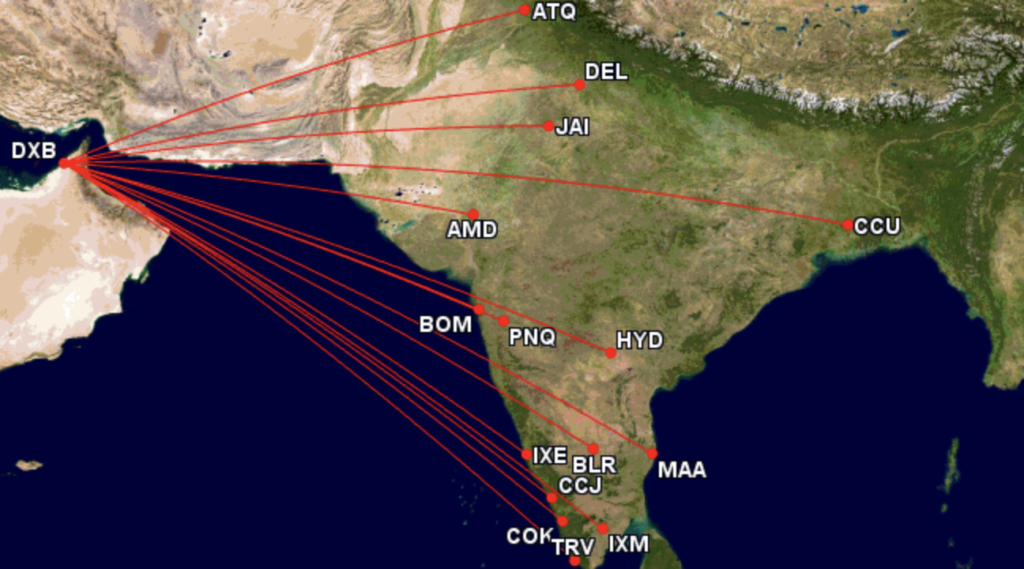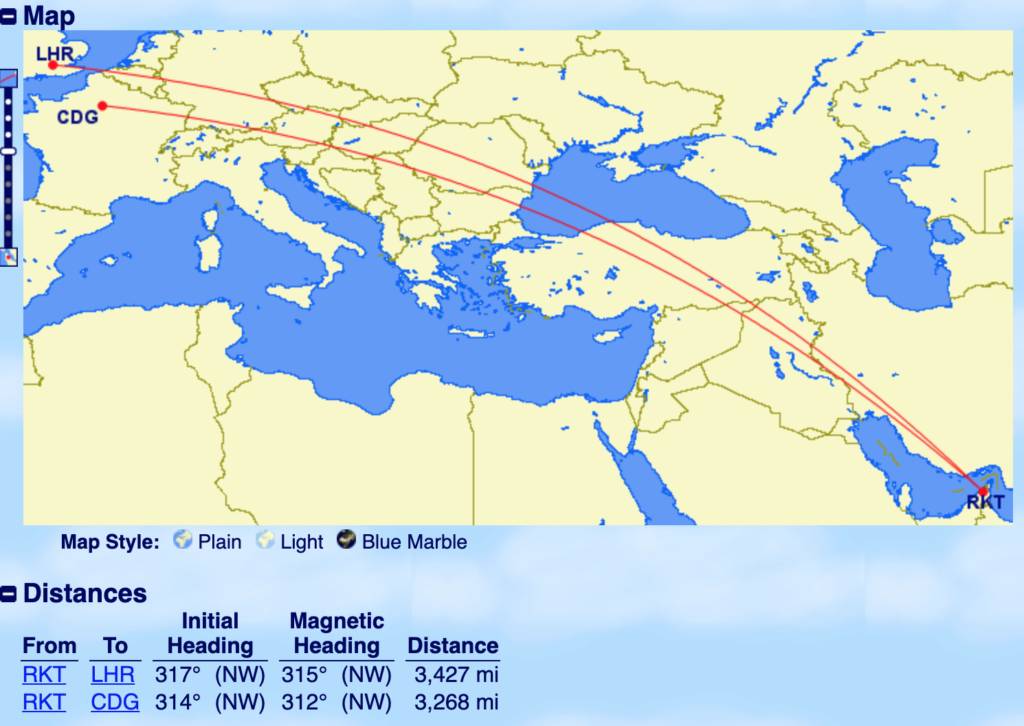SpiceJet seems to be making some ambitious moves to grow internationally. With the grounding of the 737 MAX, of which SpiceJet is a major customer, SpiceJet moved to other strategies to expand their international footprint. One of the first moves they made was to make a codeshare with Emirates, way back in April 2019.
At that point in time, both airlines stated that this would mean that there would be a large cooperation, which would primarily cover SpiceJet’s 68 weekly non-stop flights between various stops from India to Dubai and Emirates’ 170 weekly flights between India and Dubai.

However, this codeshare has still not been activated, and not sure if there is a timeline to this move altogether. SpiceJet does not show up as a partner on the Emirates partner page, unlike JetBlue, Qantas and so on which are already there.
In the wake of this, I was pretty surprised to hear a new announcement from SpiceJet on October 23, 2019, where apart from signing up for a cooperation with Ras Al Khaimah airport, Ajay Singh, the promoter chairman of the airline, announced that he would be setting up an airline at RAK to feed SpiceJet passengers to European destinations.
First some background to this. The UAE, as you know is a constellation of seven emirates. The most well-known ones are Dubai and then Abu Dhabi, but there are five more, including Ras Al Khaimah, Sharjah, Ajman, Fujairah and Umm al-Quwain. Ras Al Khaimah is right at the northmost end of the country, and about a 1:30 hours drive from Dubai.
SpiceJet Ras Al Khaimah International hub establishment
SpiceJet will set up an international hub at RAK Airport, with an intention to expand operations to Europe, Middle East and Africa. Not just that, SpiceJet intends to launch an airline based at RAK International Airport.

Image Source: https://twitter.com/ttnworldwide/status/1186894668384165888?s=20
Yesterday, October 23, 2019, the airline signed an MoU with the RAK International Airport to operate direct flights between Delhi and RAK Airport from December 2019 onwards. The plan is to launch 5 flights a week, and then increase the frequency. At present, Air India Express is the only airline operating between India and RAK Airport, operating 2 weekly flights to Kozhikode.
SpiceJet’s new airline
SpiceJet’s Ajay Singh also commented that they are going to apply for a license for a new airline, which will operate from Ras Al Khaimah, and take off next year if everything goes as per plan.
The UAE already has Emirates, Etihad, Air Arabia and flyDubai as operational airlines. Etihad and Air Arabia recently announced intentions to launch Air Arabia Abu Dhabi. As you can see, there is already competition to grab marketshare, and with the deep UAE-India ties, I would expect more airlines keeping fares low to get traffic to India.
SpiceJet intends to have four or five aircraft based in RAK. These would be 737 MAX aircraft when they get back into service. With these aircraft, SpiceJet plans to operate to Europe.
The opening of a hub outside the country is not new for Indian airline. Air India used to hub some flights out of Frankfurt circa 2013. Jet Airways used to operate a scissor hub in Brussels for about a decade, before moving it to Amsterdam in 2016.
Will this work?
The RAK airport certainly checks the boxes. For instance, UAE has strategic geographic location to connect India to Europe with the right aircraft. Jetfuel is also substantially cheaper (INR 139/gallon in the UAE v/s INR 245 in India). The range totally looks doable with the 737 MAX when it gets back in service. The 737 MAX8 has a published range of 3550 nm, and London is right almost at the end of that envelope.

The other angle to this that the RAK emirate still has seat quotas under the bilaterals. UAE has a unique arrangement with India where Dubai, Abu Dhabi, Sharjah and RAK have all negotiated individual seat capacities with India. As a part of this arrangement, there are about 1400 seats per week approved between India and Ras Al Khaimah, out of which only about 380 are used every week by the two Air India flights. So, there is room for 5 weekly flights from SpiceJet, yes, but also if SpiceJet wanted, to operate 1400 seats in the other direction with their other aircraft to be based at RAK.
Why this couldn’t work?
SpiceJet has too many things up their sleeve at the same time, and these keep popping all over the place. Do they have the ability to go through with everything is the question. For instance, they want to consider buying a 100 Airbus aircraft (mostly a negotiation tactic with Boeing, I presume). They want to take widebodies and fly directly to London. They also want to have a code-share with Emirates in the neighbourhood, and run a counter operation at an airport in North UAE doing their own flights.
Bottomline
At this point, I would be reasonably doubting the existence of the SpiceJet Emirates codeshare. And perhaps that is why this new plan to hub in UAE and make way to Europe from there. This is awfully similar to IndiGo’s Turkey push, but UAE is a much more friendly country as compared to Turkey in the current political situation. Basically, if this does work, this looks solid.
What do you make of SpiceJet Ras Al Khaimah Airport plans and launch a new airline out of there?
Like the content LiveFromALounge.com produces?
Consider sending over a small amount to allow us
to help you further in keeping you abreast with all the news you need.


Completely agree that Spicejet is doing way too many things at the same time. It seem like an overzealous child in a candy store post Jet’s demise with their push towards a business class product and then back tracking.
Getting wide bodies and flying Long haul would be a very risky move. Spicejet has major financial issues till very recently and their profitability is shaky. And transitioning to wide body operations in itself is challenging. Frankly, the viability of operating a wide body aircraft on a Long haul Mission in a Low cost config without premium cabins is unproven at best. Air Asia x is moderately successful but that too only on medium haul routes. The remaining- Wow, Norwegian have met with less then favourable results at best. Our beloved Jet Airways too suffered the perils of an over-aggressive widebody strategy that strained its cash flows and eventually saw it suffer a slow and painful death.
Spicejet would do well to stay clear of widebody operations and focus on narrow body operations like Southwest, Ryanair and Easyjet have done.
Having said that the RAK strategy could be a winner. I am certain that RAK would give them very favourable terms for their own strategic reasons. Spicejet in turn could cover much of Europe and North/central Africa with their 737 maxes. Considering O&D demand between Europe and the UAE and a vast source market like India for transit traffic, Spicejet should have no trouble filling a narrow body aircraft.
Moreover having RAK hub essentially gives Spicejet a low risk entry into Europe with minimal exit costs since they would not need to diversify their fleet or product for that matter.
With airfares rising by over 20% post 9w’s demise and ME3 carriers being more cautious in terms of capacity management, there is scope for price disruption by LCCs on India-Europe routes which was not the case earlier.
Moreover, I believe that the true potential of Spicejet’s RAK hub strategy lies in stimulating new traffic- by offering one stop connectivity to European destinations from Tier 2 and Tier 3 cities in India at Low prices. There would be a plausible case for Spicejet to stimulate such leisure driven demand that is highly price sensitive. The existing tier 1 focussed legacy carriers would be happy to cede this traffic to Spicejet since this isn’t an addressable segment for them.
The success however depends entirely on execution. Spicejet needs to stay committed to a strategy and rationalise cost and capacity to optimise profitability.